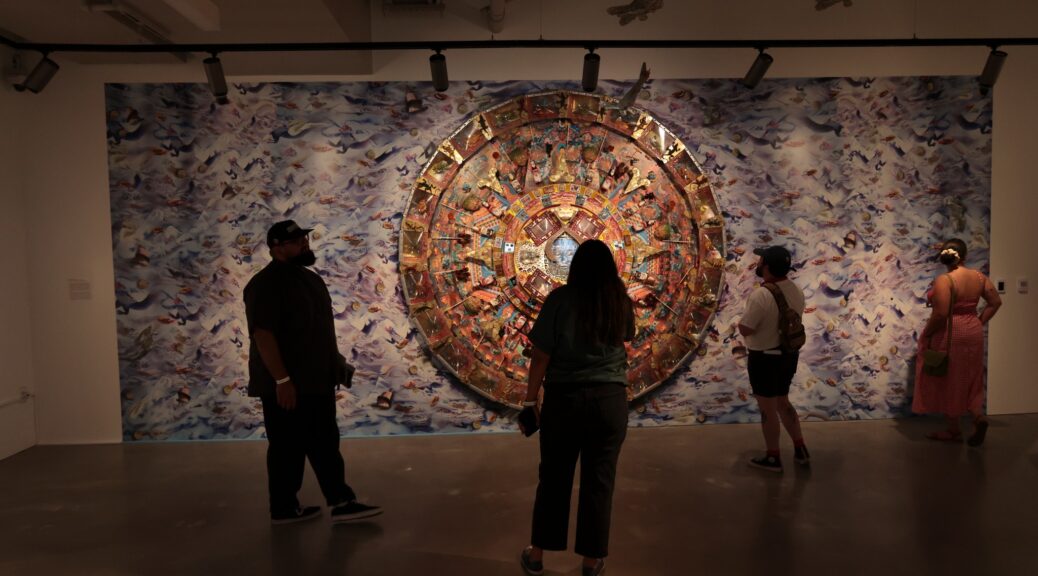I’m no artist. Never have been. I’ve always enjoyed viewing art, but I can’t draw or paint a lick. I even finished at the bottom of last December’s family cookie decorating contest.
Thankfully, the Riverside (California) Art Museum didn’t know about my failings when it asked me to become the consulting humanist for its new venture, the Cheech Marin Center for Chicano Art & Culture, better known as The Cheech. I stepped into a brand new world. Here’s what happened.
A few years ago three things occurred that ultimately gave birth to The Cheech. First, Riverside decided to build a new main library, leaving open the question: what should be done with the vacated modernist public library in the center of downtown? Second, actor-comedian-filmmaker Cheech Marín came to town with the national tour of his formidable personal collection of Chicano art. Third, Riversiders, particularly Riverside Chicanos, turned out in massive numbers, both impressing Cheech and leading to the idea of transforming our old public library into a permanent home for Cheech’s collection.
Well, it happened. A collaboration between the Art Museum, the City of Riverside, and Cheech. I’ll spare you the many details of the journey and cut directly to the chase. The Museum asked me to be the consulting humanist for the launching of this grand new initiative.
In my new role I proposed an ongoing series of filmed conversations with people involved in the creation and development of The Cheech. Artists whose work was displayed. City officials. Art Museum leaders. And, of course, Cheech himself.
Opening in June, 2022, The Cheech was organized around the idea continuity and change. Continuity: the first floor would feature a revolving selection from Cheech’s 700-piece-plus personal collection. Change: the second floor would offer a series of exhibits of outstanding Latino artists, starting with the pioneering Mexican brothers, Einar and Jamex de la Torre.
I launched Conversations at The Cheech shortly thereafter, starting with the de la Torre brothers. We held our conversation in front of the museum’s centerpiece, their jaw-dropping two-story multi-depth lenticular, which greets visitors as they enter the museum. You can look at it endlessly, because as you move from place to place, the lenticular’s myriad images change to reveal fascinating surprises, especially multiple dimensions of the Chicano experience. The lenticular has since achieved a signature print, television, and digital presence throughout the hemisphere.
Then a conversation with Cheech himself. Actually Richard Anthony Marin. We talked for nearly an hour in front of a wall featuring the Center’s name. Stories of Cheech’s past, primarily how he became an avid art collector, a stand-up comic; a filmmaker; an actor; and much more. Stories of how The Cheech came into being. Maybe most important, Cheech’s vision of diversity, especially how The Cheech could contribute to the way people of different backgrounds perceive and relate to each other.
I asked Cheech, whom does he hope visits the museum? His response was simple, elegant, and profound: everybody. He wants everybody to embrace Chicano art. Because it is unique. Because it is also part of the broader world of Latino art. Finally, because he wants Chicano and Latino art to be viewed as central to American art, both art of the United States and art of the Americas.
He wants The Cheech to contribute to an expanding vision of our nation. To champion the idea that artistic diversity adds to the American story. To demonstrate that such art can bring people together by helping broaden, deepen, and reconceptualize what it means to be an American.
Working with The Cheech, particularly through the Conversations series, has helped me rethink the idea of inclusivity, a term whose incessant, often-mindless overuse has flattened it into a virtually meaningless, knee-jerk buzz word. The Cheech represents the idea that the mutual sharing of art can contribute to a more equitable inclusivity. It does so be embodying Cheech’s vision that Chicano art and Latino art should become everybody’s art through authentic interactions, not through mere surface enjoyment or the tawdry process of cultural appropriation.
Rather art that fosters mutual enrichment, mutual respect, and mutual identification. Art that broadens our understanding of differences while simultaneously bringing us together through a recognition of commonalities. Art that positions all of us as continuously interacting contributors to a more equitably inclusive United States of America.
So what’s going to happen to these filmed Conversations? We’ll see. Right now I’m using them as a basis for a film on the opening exhibit at The Cheech. Maybe the Conversations will also be shown to visitors as part of the Center’s permanent collection. And maybe they’ll become part of a lengthier documentary film on the history of The Cheech.
In the meantime, I’ll take pleasure in watching Cheech visitors respond to this marvelous museum. Visitors of all ages and identities coming together to become part of Cheech’s vision of American inclusivity. In a world infested with professional polarizers, it’s good to see someone doing something as old-fashioned as bringing us together.
- Diversity and Speech Part 44: Generations of Gender Talk – by Carlos Cortés - March 1, 2024
- Diversity & Speech Part 43: How 3 College Presidents Flunked Their Speech Midterm Exam– by Carlos Cortés - January 29, 2024
- End of Affirmative Action? A Tale of Two Stories – by Dr. Carlos Cortés - August 8, 2023

